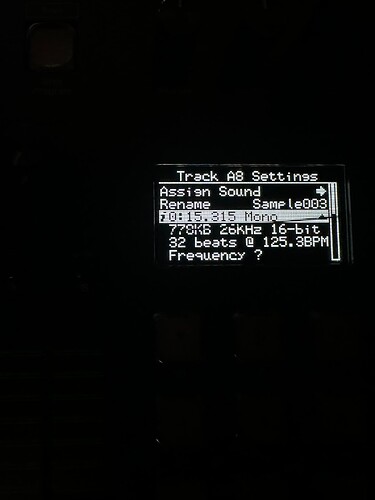Is yours the same? 05 is 12bit, it will be obviously deeper at 5~7 seconds, but the overall feeling is not much different.
All input is through line12, and analog input is turned on in the settings.
I can tell the first sample definitely has more fidelity to it compared to the second sample.
If you sample at 16 bit and then at 12 bit you should easily hear the difference. The most drastic change will be when you pitch the sample up and down.
The first one is a 12bit sample.I understand this, but it doesn’t sound as obvious as ableton and mpc simply lowering the BIT
What is your sample source? If it’s vinyl did you speed it up and then pitch it back down? If it’s a digital source did you use the internal resample to achieve the same effect?
there is a difference in recording at 12bit and just using a piece of software to “lower the bit rate” you hear the difference when pitching the sample.
I am not sure what you are expecting it to do?
All are digital sources. No action is taken. One is 12bit and the other is 16bit
Yes, both samples pass through s2400, but one is 12bit and the other is 16bit. I just feel the difference is very small
you don’t passthrough 12bit?
you need to record/sample into the machine in 12bit mode. Once again it’s when you pitch up or down the sample you will really notice the difference.
I just lament that the difference between 16bit and 12bit is very small. Yes, one is recorded in 12bit and the other is recorded in 16bit.
I know part of the magic of the sp1200 is the up and down tuning because when I switched from the PC to the s950 I was blown away by the sound. Maybe I mistakenly thought it was caused by bit changes
that is resampled at 45rpm then lowered 6 semitones on the s2400. this will definitely give you that old sampler feel. It’s just work not magic.
sorry did not gain match. just trying to help you get what you are looking for.
I understand, maybe it’s the bad lowering the bit vst that makes me think it’s the sound coming from the bit change
Because when I switched from PC to S950, the 950 just needed sample to make the sound warmer
You can get very clean samples with 12 bits. The difference between 12 and 16 bits will start to become apparent when the sample volume decreases and things start to get quiet. But depth doesn’t really start making obvious differences until you start dropping below 8-10 bits. Sample rate is going to make the most noticeable difference and cause the crunchy aliasing. Even a 16 bit sample will get crunchy and gritty if you use 20k or below sample rates.
Also the s2400 has really nice a/d conversion and won’t quite sound like a 1980s converter. Lastly, source material is going to matter as well. So if you want to start making things crunchy go in this order-
1)sample rate reduction
2)sample bit depth reduction
3)sample volume
Thank you for your reply. I have another question. Why is it displayed as 26khz 16bit when I use 12bit mode sampling?
To answer I would say that it depends on how you sampled the incoming audio. There are a few different ways to get audio into the 2400 so you can end up with different audio formats. It really is probably best to just become familiar with this part of the video manual. Everything is explained and shown in a pretty clear manner.
Ahh ok. The s2400 ignores the 4 least significant bits in 12 bit mode. So saving the 12 bit file will still save as a 16 bit wav. There isn’t really a standard 12 bit audio file format so it’s saved as 16 bits. Don’t worry though it’s 12 bit audio.
Just to nerd out a bit here: for every bit used in an audio sample you get roughly 6 dB of dynamic range. So you get about 72 dB at 12 bits vs 96 dB at 16 bits. That’s difference may seem significant on paper, but people usually sample audio content into their machines as loud as possible so you’re well above the machine’s noise floor. Unless you’re sampling something vey dynamic like a symphony orchestra piece, then you’ll barely hear a difference between 12 and 16 bits. Like some have pointed out already the crunchy tone doesn’t really come out until you start messing around with pitching your samples up and down. I’d go further to say that it’s the combination of bit depth and sample rate manipulation that really brings out crunch in a sample.
Looking at it another way, most professional tape machines used in studios to record music up until the 1980s had around 60-70 dB of dynamic range. You would still only hear noise in the quieter parts of a recording. These recordings sound nice and clean until you start messing with the playback speed of the tape.


